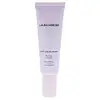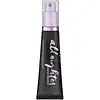What's inside
What's inside
 Key Ingredients
Key Ingredients

 Benefits
Benefits

 Concerns
Concerns

 Ingredients Side-by-side
Ingredients Side-by-side

Water
Skin ConditioningMethyl Methacrylate Crosspolymer
Butylene Glycol
HumectantGlycerin
HumectantPropanediol
SolventTriethylhexanoin
MaskingIsopropyl Myristate
EmollientSynthetic Wax
AbrasivePhenoxyethanol
PreservativeSqualane
EmollientPlankton Extract
Skin ConditioningAmmonium Acryloyldimethyltaurate/Vp Copolymer
Hydroxyethyl Acrylate/Sodium Acryloyldimethyl Taurate Copolymer
Emulsion StabilisingSilica
AbrasivePolyvinyl Alcohol
BHT
AntioxidantAcrylates/C10-30 Alkyl Acrylate Crosspolymer
Emulsion StabilisingPolysorbate 60
EmulsifyingPotassium Hydroxide
BufferingCI 77491
Cosmetic ColorantCI 77492
Cosmetic ColorantWater, Methyl Methacrylate Crosspolymer, Butylene Glycol, Glycerin, Propanediol, Triethylhexanoin, Isopropyl Myristate, Synthetic Wax, Phenoxyethanol, Squalane, Plankton Extract, Ammonium Acryloyldimethyltaurate/Vp Copolymer, Hydroxyethyl Acrylate/Sodium Acryloyldimethyl Taurate Copolymer, Silica, Polyvinyl Alcohol, BHT, Acrylates/C10-30 Alkyl Acrylate Crosspolymer, Polysorbate 60, Potassium Hydroxide, CI 77491, CI 77492
Water
Skin ConditioningButylene Glycol
HumectantPolyacrylamide
Ethylhexyl Palmitate
EmollientGlycerin
HumectantC13-14 Isoparaffin
EmollientPhenoxyethanol
PreservativeCaprylyl Glycol
EmollientPullulan
Laureth-7
EmulsifyingTocopheryl Acetate
AntioxidantTetrahexyldecyl Ascorbate
AntioxidantSilica Dimethyl Silylate
EmollientNannochloropsis Oculata Extract
HumectantCarbomer
Emulsion StabilisingSodium Lactate
BufferingPotassium Sorbate
PreservativeTriethanolamine
BufferingSodium Benzoate
MaskingLitchi Chinensis Pericarp Extract
Skin ConditioningPolysorbate 20
EmulsifyingSodium Hyaluronate
HumectantHexylene Glycol
EmulsifyingPalmitoyl Tripeptide-1
Skin ConditioningPalmitoyl Tetrapeptide-7
Skin ConditioningWater, Butylene Glycol, Polyacrylamide, Ethylhexyl Palmitate, Glycerin, C13-14 Isoparaffin, Phenoxyethanol, Caprylyl Glycol, Pullulan, Laureth-7, Tocopheryl Acetate, Tetrahexyldecyl Ascorbate, Silica Dimethyl Silylate, Nannochloropsis Oculata Extract, Carbomer, Sodium Lactate, Potassium Sorbate, Triethanolamine, Sodium Benzoate, Litchi Chinensis Pericarp Extract, Polysorbate 20, Sodium Hyaluronate, Hexylene Glycol, Palmitoyl Tripeptide-1, Palmitoyl Tetrapeptide-7
 Reviews
Reviews

Ingredients Explained
These ingredients are found in both products.
Ingredients higher up in an ingredient list are typically present in a larger amount.
Butylene Glycol (or BG) is used within cosmetic products for a few different reasons:
Overall, Butylene Glycol is a safe and well-rounded ingredient that works well with other ingredients.
Though this ingredient works well with most skin types, some people with sensitive skin may experience a reaction such as allergic rashes, closed comedones, or itchiness.
Learn more about Butylene GlycolGlycerin is already naturally found in your skin. It helps moisturize and protect your skin.
A study from 2016 found glycerin to be more effective as a humectant than AHAs and hyaluronic acid.
As a humectant, it helps the skin stay hydrated by pulling moisture to your skin. The low molecular weight of glycerin allows it to pull moisture into the deeper layers of your skin.
Hydrated skin improves your skin barrier; Your skin barrier helps protect against irritants and bacteria.
Glycerin has also been found to have antimicrobial and antiviral properties. Due to these properties, glycerin is often used in wound and burn treatments.
In cosmetics, glycerin is usually derived from plants such as soybean or palm. However, it can also be sourced from animals, such as tallow or animal fat.
This ingredient is organic, colorless, odorless, and non-toxic.
Glycerin is the name for this ingredient in American English. British English uses Glycerol/Glycerine.
Learn more about GlycerinPhenoxyethanol is a preservative that has germicide, antimicrobial, and aromatic properties. Studies show that phenoxyethanol can prevent microbial growth. By itself, it has a scent that is similar to that of a rose.
It's often used in formulations along with Caprylyl Glycol to preserve the shelf life of products.
Water. It's the most common cosmetic ingredient of all. You'll usually see it at the top of ingredient lists, meaning that it makes up the largest part of the product.
So why is it so popular? Water most often acts as a solvent - this means that it helps dissolve other ingredients into the formulation.
You'll also recognize water as that liquid we all need to stay alive. If you see this, drink a glass of water. Stay hydrated!
Learn more about Water